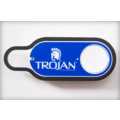Dignity Institute – Talking Bones – (2016) 1:47 (France)
Posted in: UncategorizedGrey Paris wanted to show you you what you can’t see, and took x-rays of the victims. They then put the victim’s audio testimonies on their own medical x-rays. Place the x-ray on a turntable and you can play it like a vinyl record and listen to Arta’s, Adnan’s and Fidele’s stories. Hearing the victims tell of what happened, while you can see their physical injures is a reality-jab. It becomes impossible to ignore. You can take a closer look at the x-rays here.
Grey Paris sent vinyl records to key French influencers to create a real conversation about this highly sensitive subject.
The hashtag #TALKINGBONES is spreading on social media, and you can learn more at talking bones.
Dignity Institute, talking bones DM images
Posted in: UncategorizedWhile you can watch the case study explanation of the “talking bones” campaign here, the x-ray records need to be seen on their own. The x-rays are of Arta, Adnan and Fideles bones, revealing the torture that their bodies have suffered through. Arta’s, Adnan’s and Fidele’s stories were then recorded onto vinyl, which had the X-ray of them on it. You’d see the damage and hear the stories at the same time.
Kismet "VR launch trailer" (2016) :50 (USA)
Posted in: UncategorizedPowered by a deck of 22 hand-painted Tarot cards and an accurate real-time map of the solar system, Kismet is meant to be experienced daily, with unique outcomes every calendar day that are directly tied to not only the cards that you choose, but your individual birth date and the actual alignment of celestial bodies at the time of your reading. Seated across a table from an enchanted automaton with the power to look into the future, you’ll be transported to a place where magic is real. Named after the mysterious character at its core, Kismet is inspired by the mystic arts of Tarot and Astrology, brought to life in a beautifully detailed, handmade, gothic style.
Kismet sets itself apart from other VR experiences by delivering the antidote to the many adrenaline-fueled, hardcore game experiences that populate the current marketplace. Rather than pilot spaceships or wield weapons of destruction, Kismet uses VR as a bridge to a more contemplative, spiritual place. Kismet was designed as a broadly inviting experience meant to provoke thought and discussion and appeal to a wide audience.
“I’ve been obsessed with mechanical fortune telling machines ever since I was a child,” says David Chontos, Writer and Director. “Virtual reality has given me a platform to not only create one of those machines entirely from my own imagination, but to step inside of it, and to invite the rest of the world inside with me.”
Kismet is now available for $6.99 on SteamVR for HTC Vive and Oculus Rift. It will be on sale for $4.99 on SteamVR for the first week. Coming Soon to the Oculus Home.
Check out more info here.
Family Matters – 360 Experience / Do Not Look The Other Way (2016) case study (Russia)
Posted in: UncategorizedFrom the experience of “Family Matters” psychological aid center, domestic violence victims are rarely capable of solving their problems by themselves. As a rule, they justify their tormenters or prefer to keep it secret. Thus, it is extremely important to change public opinion and tell people how to behave having spotted signs of domestic violence.
BBDO Russia Group and the “Family Matters” psychological aid center created a video warning people not to turn their back on a woman being beaten in a family. It’s a 360 experience on youtube.
“Our video is purposely lacking action”, says Kirill Tsytkin, BBDO copywriter. “The first second you see a woman turning her eyes from the camera and a text going out of the eyesight. You can stay with the woman or follow the text. However, whatever you choose, you’ll have to watch the video again to see the story from all sides”.
Why is ad blockers sharing ad revenue with publishers so controversial?
Posted in: Uncategorizedinclude a feature that will allow users to pay for the sites that they visit most often. This comes through a partnership with Sweden-based content-funding startup Flattr, founded by Peter Sunde and Linus Olsson. Peter Sunde is most well known for having been the spokesperson of The Pirate Bay, which eventually got him convicted for piracy and eventually listed on the National Criminal group of international fugitives. Flattr has their headquarter in Malmö, Sweden and was founded in 2010. Flattr and Adblock Plus will keep a 10% cut of the revenue generated, while the remaining revenue will be divided up and handed to publishers based on “engagement”. They’re currently working on an algorithm to determine what “engagement” actually means.
Not everyone is impressed by Adblock Plus’s foray into the micropayment area, even though it’s not news. Eyeo has a minority ownership stake in Flattr and they’re been testing the waters for micropayments for some time, as well as explored the possibilities of acceptable ads, and substituting ads on websites directly, or at least allowing specific ads to come through. This feature was used by Amnesty International, where their ads only were allowed to penetrate the adblock on websites for a day. Fortune says that Flattr & Adblock Plus plan to generate $500M for publishers in 2017.
Publishers are wary of these ideas. With Adblock Plus doing this, it looks like a shakedown to some publishers. “Nice website you got there, would be a shame if nobody saw your ads”. Adblock Plus positioning themselves to take 10% of anything donated to the content producers via Flattr won’t settle that feeling. Meanwhile Telecoms are substituting ads on websites, as they literally own the road to the internet and can do this. Everyone wants a slice of the ad network revenue, for that is where the real money lies. When Brave browser appeared as a solution to clunky slow ad ridden browsers, the Newspaper Association of America sent a cease and desist letter to them, protesting what they saw as digital theft of their revenue.
Your plan to use our content to sell your advertising is indistinguishable from a plan to steal our content to publish on your own website. Your public statements demonstrate
clearly that you intend to harness and exploit the content of all the publishers on the Web to sell your own advertising.
Brave fought back saying that the NAA has misunderstood, and misrepresented how a browser actually works. From their block post:
Furthermore, the NAA’s letter misconstrues how Web standards and browsers work by design: the Web is a system that allows users to consume content in any combination and presentation that user-chosen software can achieve. Browsers do not “republish”, copy, serve, syndicate, or distribute content across the Internet or to any computer other than the one on which they run.
With our ad-share model, the default money flow directs up to 70% of ad revenue to site publishers – far greater than the average percentage in the current programmatic display ad ecosystem. Brave keeps 15%, and allows the end-user to choose whether to donate or keep their 15% share. Keeping their share still results in 55% ad rev share to site owners – beating the current average of 45%. Take a look at our Brave User Paths from Browsing to Ad Rev sharing.
It’s not that the solutions are wrong in our micropayment and ad blocking browser ideas, it’s that the publications took a wrong turn 15 years ago when they put all of their eggs in the ad revenue basket. Micropayments have been discussed for over 20 years now, with Scott McCloud’s 2000 book ‘Reinventing Comics’ convincing many creative people that this was the future. It’s the publishers who were too slow to adapt, and without a central simple system, the micropayment clicks won’t be happening. Since credit cards and online banks also take a share of each action, a penny donated to a website results in the site getting a fraction of that penny. The biggest success of micro payments is iTunes that showed us we would buy a song for a dollar, and spawned several similar services.
Another fundamental misunderstanding from the publishers, is that people think the ads are “bad” or uncreative in some way. While ads that pop-up, pop-under, asks us to punch a monkey or autoplay a video or sound are all examples of ad annoyances, it’s the privacy breach that bothers people. Not just the poor creative. Ad buyers are increasingly realising that digital paid media is a fraud, those 3-second rollovers on Facebook “count” as a view but nobody saw your ad. In the end, the annoyance stems from the same old thing – the path from reader and “payer” of content to creator & maker of content has too many people in the middle taking their percentages at every turn. The calls to third party venders violate both the readers and the publishers privacy, and people actually care about their privacy rights..
Orleans Coffee – new logo & identity created by Cerberus
Posted in: UncategorizedOrleans Coffee has undergone a complete rebranding, there was this print campaign setting the new tone, but the agency Cerberus also created new logo, packaging, and vehicle designs for them. The ornate logo visually nods to old-school irons sign and french quarter iron balconies, while the light coffee brown feels refreshingly understated and modern compared to some of the brighter colours currently popular. Even Pantone has been on a light pastel kick for a couple of years now.
Estudiantes de Caracas Football Club: Little Kicks
Posted in: Uncategorized

The first football match played by kids who aren’t born yet.
Masters of Prose Warm Up to Children’s Picture Books
Posted in: UncategorizedWell-known writers like Jane Smiley, Calvin Trillin and Elena Ferrante are turning their talents toward a booming genre, aiming to draw younger readers.
Top 65 Start-Up Innovations in May – From Ethical Investing Tools to IoT Service Providers (TOPLIST)
Posted in: UncategorizedTop 30 E-Commerce Ideas in May – From 360-Degree E-Commerce Shops to Social Selling Apps (TOPLIST)
Posted in: UncategorizedMaritime Virtual Coastguard – case study 1:50 (New Zealand)
Posted in: UncategorizedTo help enforce safety, Maritime New Zealand and FCB New Zealand developed the world’s first “Virtual Coast Guard”, an always-on system that patrols more than 9,000 miles of New Zealand’s coastline powered by using geo-fence technology. Knowing that boaters are on their phones capturing photos and checking weather conditions, the virtual system is able to target them through ads on mobile apps and websites to serve them a reminder to wear their life jacket, a warning if danger is imminent based on their location and other important safety messages.
Cinema to Go by Air France – (2016) :50 (France)
Posted in: UncategorizedHostelworld "Skinny dipping" (2016) 1:00 (UK)
Posted in: UncategorizedWunderman Creative Director creates baby case study to announce paternity leave
Posted in: UncategorizedAs a Creative Director, taking even a day off seems like it’s impossible as you’d be asked for input on things, emailed, called up and texted either way. So what do you do when you need to be out of the office for a month? Well, since it’s the Creative Director of Wunderman Portugal, Luís Coelho paternity leave, he had a creative solution to explaining his absence. He would be Out Of the Office to attend to his latest work in progress, his daughter Sofia – and he has the case study board to prove it.
Congratulations Luís Coelho and Mom, Sofia is adorable.
California REALTORS now have their own emojis
Posted in: UncategorizedJudging by the reviews of the app, the only people who like it are realtors. No-realtor people are not happy with the idea that in order to use the app, one must give it access to everything. Take this review for instance by Tulabelle:
“Help me understand why one MUST agree to give up their privacy when agreeing to use this APP?! By agreeing you tell them they can use ANYTHING you have ever typed including credit card numbers and private communications. You think you have a reasonable right to privacy but your (sic) agreeing take it away!!!!!!”
Not a good look, C.A.R.
Client: California REALTORS
Agency: Red Tettemer O’Connell + Partners
Chief Creative Officer: Steve Red
Executive Creative Director: Steve O’Connell
VP, Group Creative Director: Todd Taylor
VP, Group Creative Director: Ryan Scott
Managing Partner: Carla Mote
Designer: Dave Wiest
Copywriter: Megan Auld-Wright
VP, Digital Strategy: Uri Weingarten
Interactive Creative Director: Derek Little
Tech lead: Aaron Grando
Digital Strategist: Josh Sirulnik
VP, Director of Client Services: Susan Baraczek
Account Manager: Gillian Darr














